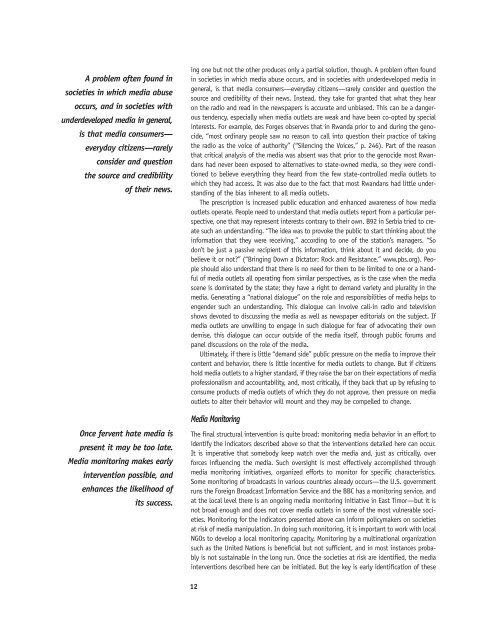Institutional Racism
Institutional Racism
Institutional Racism
You also want an ePaper? Increase the reach of your titles
YUMPU automatically turns print PDFs into web optimized ePapers that Google loves.
A problem often found in<br />
societies in which media abuse<br />
occurs, and in societies with<br />
underdeveloped media in general,<br />
is that media consumers—<br />
everyday citizens—rarely<br />
consider and question<br />
the source and credibility<br />
of their news.<br />
Once fervent hate media is<br />
present it may be too late.<br />
Media monitoring makes early<br />
intervention possible, and<br />
enhances the likelihood of<br />
its success.<br />
ing one but not the other produces only a partial solution, though. A problem often found<br />
in societies in which media abuse occurs, and in societies with underdeveloped media in<br />
general, is that media consumers—everyday citizens—rarely consider and question the<br />
source and credibility of their news. Instead, they take for granted that what they hear<br />
on the radio and read in the newspapers is accurate and unbiased. This can be a dangerous<br />
tendency, especially when media outlets are weak and have been co-opted by special<br />
interests. For example, des Forges observes that in Rwanda prior to and during the genocide,<br />
“most ordinary people saw no reason to call into question their practice of taking<br />
the radio as the voice of authority” (“Silencing the Voices,” p. 246). Part of the reason<br />
that critical analysis of the media was absent was that prior to the genocide most Rwandans<br />
had never been exposed to alternatives to state-owned media, so they were conditioned<br />
to believe everything they heard from the few state-controlled media outlets to<br />
which they had access. It was also due to the fact that most Rwandans had little understanding<br />
of the bias inherent to all media outlets.<br />
The prescription is increased public education and enhanced awareness of how media<br />
outlets operate. People need to understand that media outlets report from a particular perspective,<br />
one that may represent interests contrary to their own. B92 in Serbia tried to create<br />
such an understanding. “The idea was to provoke the public to start thinking about the<br />
information that they were receiving,” according to one of the station’s managers. “So<br />
don’t be just a passive recipient of this information, think about it and decide, do you<br />
believe it or not?” (“Bringing Down a Dictator: Rock and Resistance,” www.pbs.org). People<br />
should also understand that there is no need for them to be limited to one or a handful<br />
of media outlets all operating from similar perspectives, as is the case when the media<br />
scene is dominated by the state; they have a right to demand variety and plurality in the<br />
media. Generating a “national dialogue” on the role and responsibilities of media helps to<br />
engender such an understanding. This dialogue can involve call-in radio and television<br />
shows devoted to discussing the media as well as newspaper editorials on the subject. If<br />
media outlets are unwilling to engage in such dialogue for fear of advocating their own<br />
demise, this dialogue can occur outside of the media itself, through public forums and<br />
panel discussions on the role of the media.<br />
Ultimately, if there is little “demand side” public pressure on the media to improve their<br />
content and behavior, there is little incentive for media outlets to change. But if citizens<br />
hold media outlets to a higher standard, if they raise the bar on their expectations of media<br />
professionalism and accountability, and, most critically, if they back that up by refusing to<br />
consume products of media outlets of which they do not approve, then pressure on media<br />
outlets to alter their behavior will mount and they may be compelled to change.<br />
Media Monitoring<br />
The final structural intervention is quite broad: monitoring media behavior in an effort to<br />
identify the indicators described above so that the interventions detailed here can occur.<br />
It is imperative that somebody keep watch over the media and, just as critically, over<br />
forces influencing the media. Such oversight is most effectively accomplished through<br />
media monitoring initiatives, organized efforts to monitor for specific characteristics.<br />
Some monitoring of broadcasts in various countries already occurs—the U.S. government<br />
runs the Foreign Broadcast Information Service and the BBC has a monitoring service, and<br />
at the local level there is an ongoing media monitoring initiative in East Timor—but it is<br />
not broad enough and does not cover media outlets in some of the most vulnerable societies.<br />
Monitoring for the indicators presented above can inform policymakers on societies<br />
at risk of media manipulation. In doing such monitoring, it is important to work with local<br />
NGOs to develop a local monitoring capacity. Monitoring by a multinational organization<br />
such as the United Nations is beneficial but not sufficient, and in most instances probably<br />
is not sustainable in the long run. Once the societies at risk are identified, the media<br />
interventions described here can be initiated. But the key is early identification of these<br />
12

















